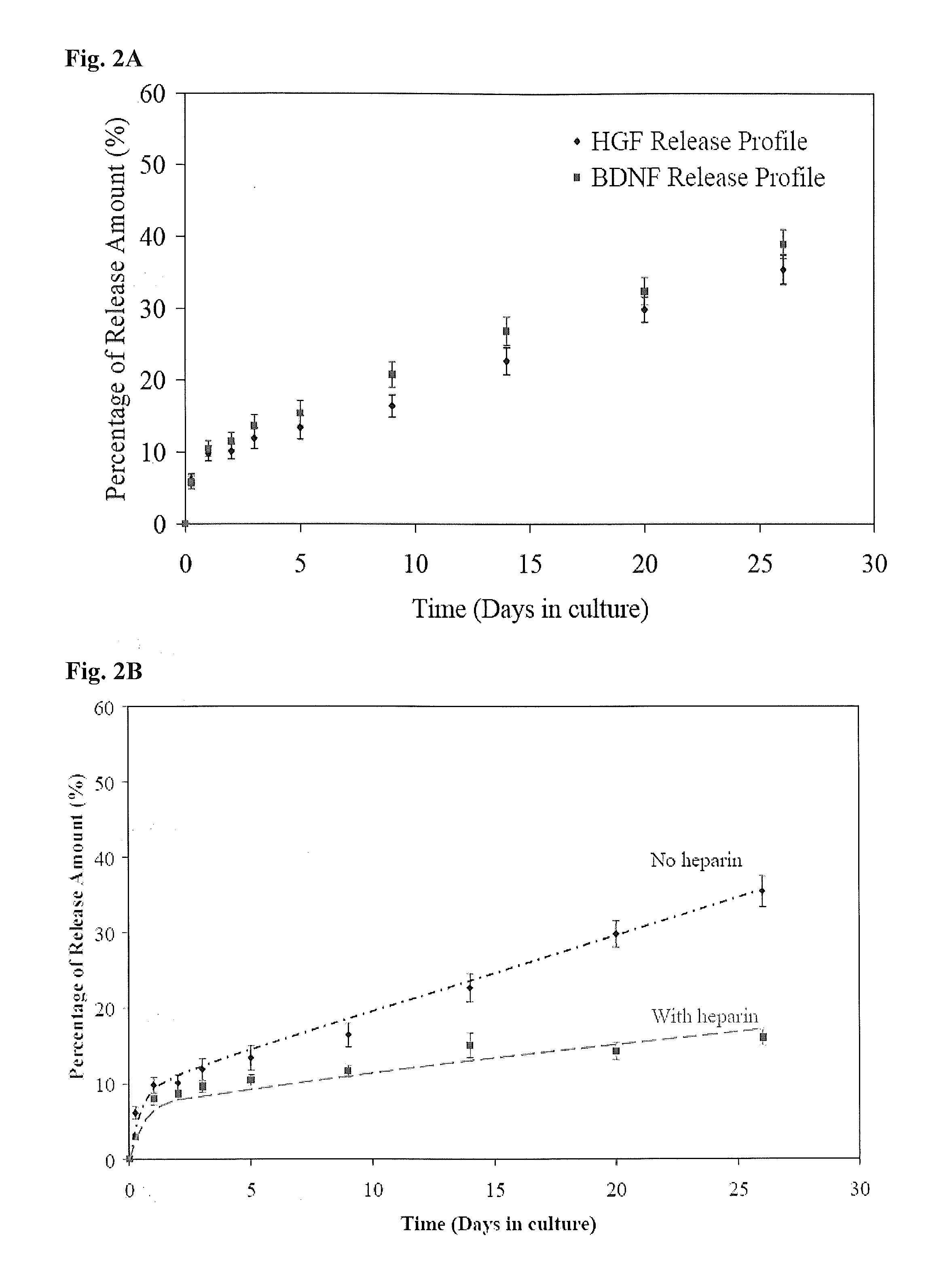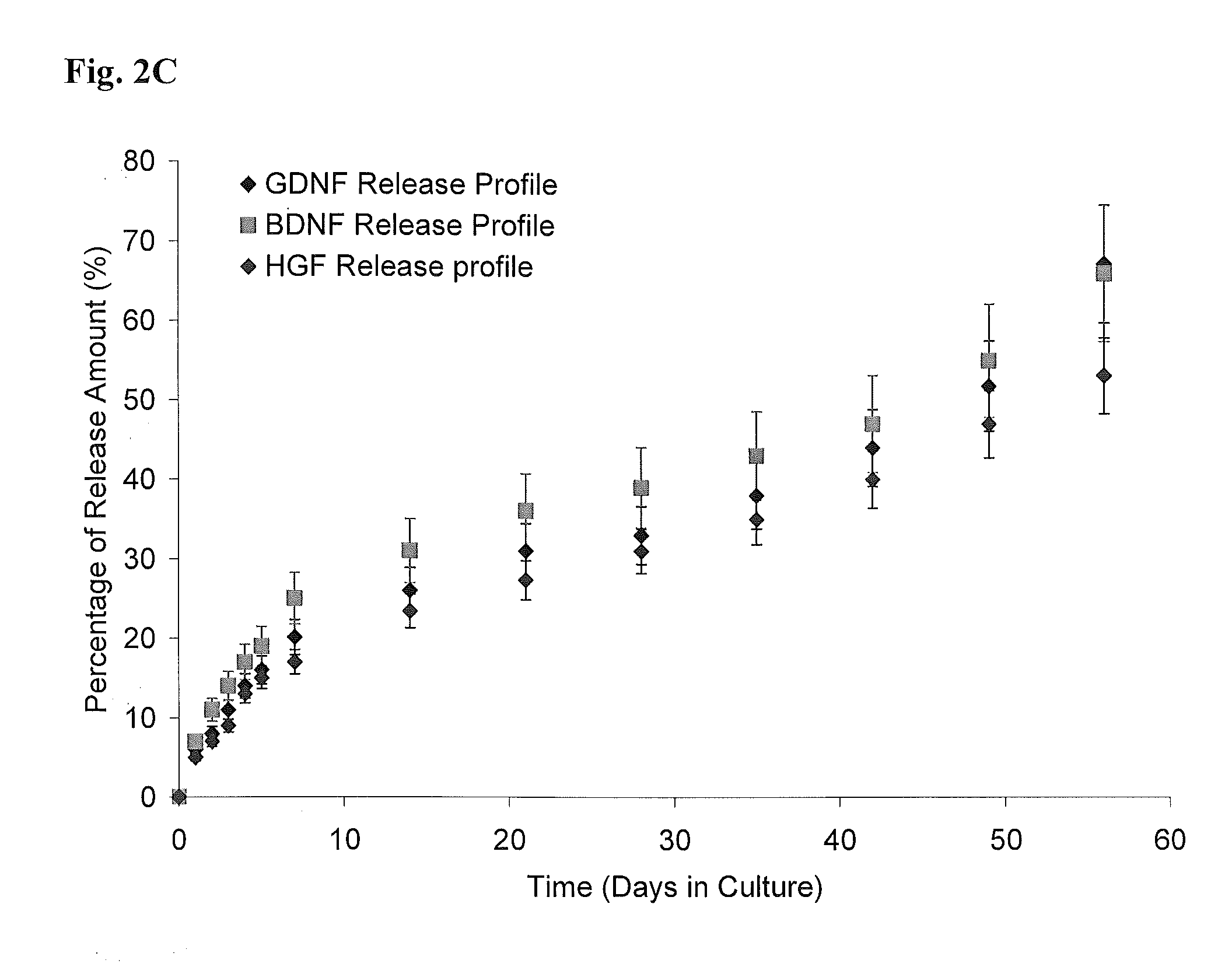Methods for Promoting the Revascularization and Reenervation of CNS Lesions
a technology of cns and reenervation, applied in the direction of peptide/protein ingredients, prosthesis, peptide sources, etc., can solve the problems of limited success of neural transplantation for cerebral stroke repair, no effective treatment for cerebral stroke in clinical settings, and patients who survive stroke usually remain severely disabled and require constant care for the rest of their lives. , to achieve the effect of reducing the inhibition of axonal regeneration
- Summary
- Abstract
- Description
- Claims
- Application Information
AI Technical Summary
Benefits of technology
Problems solved by technology
Method used
Image
Examples
example 1
Composition of Synthetic Hydrogels
[0138]FIGS. 1A-C show human embryonic stem cell derived neurospheres cultured in hydrogels comprising different ratios of 4-Arm PEG and short peptide sequence (CDPVCC GTARPGYIGSRGTARCCAC). While all of the hydrogels supported growth of the cells, a PEG:peptide ratio of 25:75 produced the best results.
example 2
Sustained Release of Biologically Active Molecules grom in-situ Crosslinkable Hydrogels
[0139]FIGS. 2A-C show sustained release of biologically active molecules from an ECM-based hydrogel. (A) Cumulative in vitro HGF and BDNF release from an ECM-based hydrogel comprising hyaluronic acid and collagen. After 26 days, approximately 35-40% of each growth factor was released from each hydrogel. (B) Cumulative in vitro HGF release from ECM-based hydrogels comprising hyaluronic acid and collagen (circles), or hyaluronic acid, collagen and heparin (squares). Addition of heparin in HA-collagen hydrogel doubles the release duration of HGF from the hydrogels. The hydrogel provides sustained release of biologically active growth factor in vitro, with release sustained for 3-6 months. This is a dramatic increase in time of availability compared to the short half-life of free growth factors in vivo. (C) Cumulative in vitro GDNF, BDNF and HGF release from the synthetic hydrogel. After 1 and 2 month...
example 3
Attracting Stem Cells in Vitro and in Vivo
[0140]FIGS. 3A-B show recruitment of stein cells to in-situ crosslinkable hydrogels containing hepatocyte growth factor (HGF). Neural stem cells (5×103 in 200 μl culture media) were added to the upper compartment of a transwell. The lower compartment was filled with 400 μl of culture medium and an in-situ crosslinkable hydrogel as control (A), or an in-situ crosslinkable hydrogel containing 80 ng / ml solubilized HGF (B). Hydrogels were harvested following an 8-hour incubation period and stained. Sustained and localized release of HGF from the hydrogel (B) is able to induce neural stem cell migration and recruitment into the hydrogel.
[0141]FIGS. 4A-D show recruitment of endogenous stein cells to ECM-based hydrogels containing hepatocyte growth factor (HGF). ECM-based hydrogels loaded with control (A) or HGF (B) were implanted into the subcutaneous space on the back of mice. Hydrogels were harvested 1 week after implantation and samples of each...
PUM
| Property | Measurement | Unit |
|---|---|---|
| concentrations | aaaaa | aaaaa |
| concentration | aaaaa | aaaaa |
| concentration | aaaaa | aaaaa |
Abstract
Description
Claims
Application Information
 Login to View More
Login to View More - R&D
- Intellectual Property
- Life Sciences
- Materials
- Tech Scout
- Unparalleled Data Quality
- Higher Quality Content
- 60% Fewer Hallucinations
Browse by: Latest US Patents, China's latest patents, Technical Efficacy Thesaurus, Application Domain, Technology Topic, Popular Technical Reports.
© 2025 PatSnap. All rights reserved.Legal|Privacy policy|Modern Slavery Act Transparency Statement|Sitemap|About US| Contact US: help@patsnap.com



